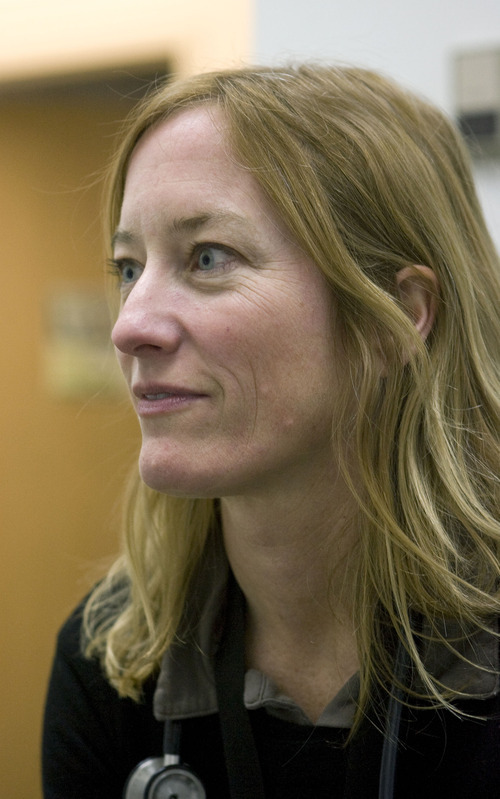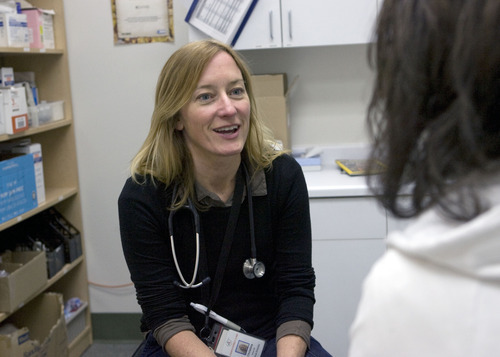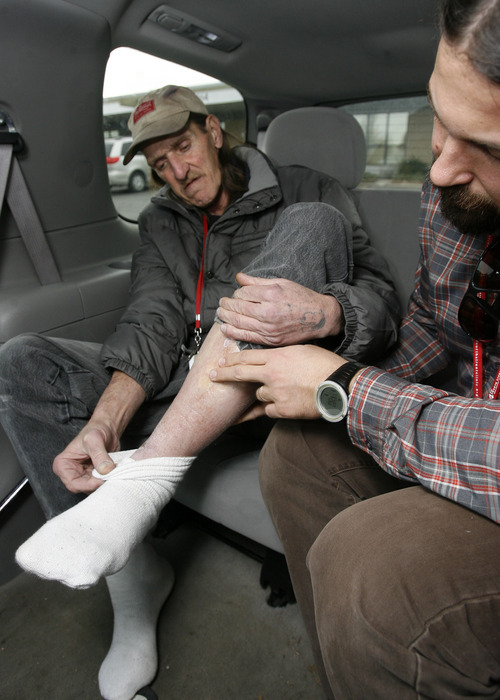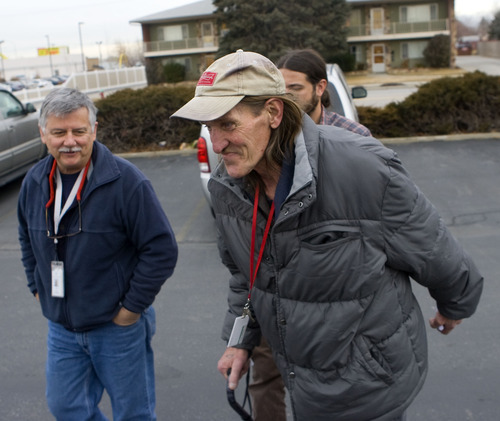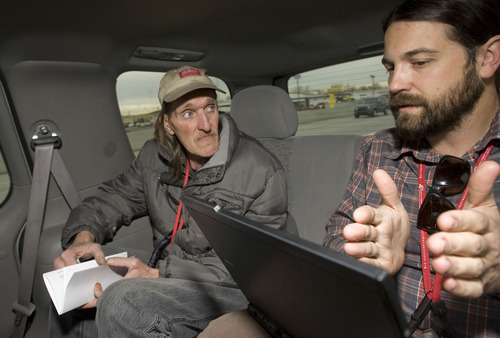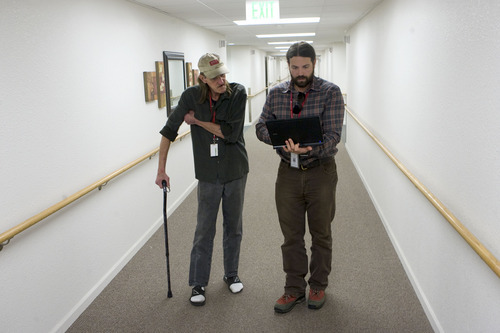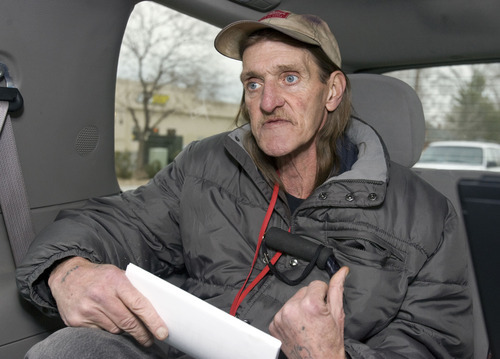This is an archived article that was published on sltrib.com in 2012, and information in the article may be outdated. It is provided only for personal research purposes and may not be reprinted.
Editor's note: Details about Joseph Koch — a pseudonym — were obtained from court documents, other records and interviews, including Koch. But The Salt Lake Tribune chose to use a pseudonym to protect his medical privacy.
—
Joseph Koch was weathered and muscular for a man in his 60s.
The career tile layer was never seen panhandling, had only minor run-ins with the law and was agreeable when he wasn't drinking. On the streets he usually kept to himself, unnoticed by most except the cops and fire crews who lost count of the times they picked him up, intoxicated, unconscious and soaked in urine and feces.
Like many of the homeless and uninsured, Koch - a pseudonym - frequently surfaced in emergency rooms. His record, though, was unparalleled: over 16 months, between January 2010 and April 2011, he racked up 93 ER visits, hitting every major hospital in the Salt Lake Valley.
Some days, after being discharged, he'd make it only as far as the closest convenience store, where he'd down a bottle of mouthwash, pass out and get picked up again, said Ed Snoddy, a medical outreach worker for the homeless. At Pioneer Valley Hospital, where one day he showed up six times, Snoddy said, staff called him "Minty Fresh."
His estimated ER bill: $418,000. And that doesn't include ambulance rides, X-rays, tests, treatments and several stays in intensive care.
If Koch embodies what's broken in health care, he's also a catalyst for change, compelling Utah's fragmented system to rally behind a new strategy of caring for the sickest and costliest patients.
Called "hot spotting," it's taking root in cities across America and, some say, points the way to lowering the nation's health costs.
"Individually everyone had thrown up their hands and said, there's nothing we can do for this guy," said Christina Gallop, medical director at Fourth Street, a downtown clinic for the homeless. "It took everyone coming together and talking to find a solution."
—
'What are you guys doing?' • Gallop, a 47-year-old internist, pedals home every evening through Salt Lake City's homeless corridor, past the Road Home shelter, Salvation Army's food kitchen and sleeping-bag studded Pioneer Park.
One day it struck her: "Who are these people? They were clearly homeless. But I had never seen them in my clinic."
Exasperated police, ambulance crews and emergency room staff were seeing them instead.
The drive to curb health spending has put a spotlight on such "high utilizers," the 20 percent of Americans who consume 80 percent of all health care.
Hot-spotting directs preventive resources to them. The strategy was developed by a New York City police commissioner who mapped high-crime areas, blanketed them with extra officers and lowered the city's crime rate. The idea has moved into education, efforts to combat homelessness and now, health care.
Five years ago, when Gallop came on board, the Fourth Street clinic operated like an urgent care for the uninsured and homeless queuing up outside. But with a grant, Gallop and Fourth Street's client Director Monte Hanks hired more hands to provide manage care and experiment with hot-spotting.
She asked emergency responders to steer homeless frequent fliers her way - and heard pent-up frustration.
"Someone at the fire department would say, 'I've picked up this guy 20 times this month. What are you guys doing?' " recalls Gallop, who explained, "I can't help you if I don't know there's a man down in Pioneer Park. You people are our eyes and ears."
The Salt Lake City Fire Department had tried to divert refugees, the homeless and homebound seniors with minor ailments to community clinics - but few clinics were open at night or on weekends, and few taxi drivers wanted to help with the driving, said Fire Capt. Tom Burckhard.
The initiative fizzled. There wasn't much incentive to try again, because for emergency crews, "there's no savings," said Scott Youngquist, an attending physician in the University of Utah Hospital's emergency department.
"An ambulance needs to be fully manned to meet the community's emergency needs, no matter the need," he said. "We're a one-stop shop, and it's quicker for them to pick up a patient, stabilize them, drop them off and get to the next call."
—
'A wake up call' • Emergency room staff, who can't turn patients away, are the fallback. ERs are the path to care for the uninsured and where patients end up when preventive care fails.
Insurers and hospitals could use their mounds of data to target care to patients who are slipping, skipping checkups and screenings or misusing ERs. But in Utah, tracking patients across half-a-dozen insurance companies and four major hospital chains is a technological challenge and raises privacy concerns.
Some states are refusing to pay ER bills for Medicaid patients who receive non-emergency care. Utah has restricted access for high users, such as requiring them to see a family doctor to get prescriptions filled.
Still, there were 619 Utahns on Medicaid last year who each racked up 10 or more emergency room visits. Of those patients, 74 were already on the restricted list.
Utah Inspector General Lee Wyckoff hasn't yet analyzed the patients' records but fears many were abusing the ER.
Youngquist doesn't like the idea of legislating what's an emergency. The answer for people who cycle in and out of ERs isn't barring them, but getting them the care they need, he said.
With input from him and others, Fourth Street devised a way to do that for the homeless.
Clinic staff are on-call to answer questions around the clock. The clinic has evening hours and is open Saturday mornings.
"We said, 'Don't send them to us in a week and don't refill their meds. Put them in a cab and send them to us now,' " said Gallop." It was really a wake-up call. They can't just be an ER and we can't just be a clinic."
A two-man emergency team - Ed Snoddy and physician's assistant Joel Hunt - was created, to dispatch to hospitals and to treat patients on the street.
Hospitals had no reliable way to determine who among their high users were homeless. And privacy laws barred them from sharing names with Fourth Street. But Snoddy, who has worked with the homeless for years, had a hunch that Koch topped everyone's list and pushed to intervene. Data later confirmed he was right.
—
'We tried everything' • Koch said he started drinking and using drugs at the age of 13, according to Snoddy. He tried kicking the habit, but always relapsed. At some point in the late '80s or early '90s, he quit working. He divorced his wife and wore out his welcome with other family members.
"We would meet him at the ER or where the EMTs found him and take him to jail if he had warrants. If he was nonresponsive, he would go to ER, and if lucid enough, we'd take him to detox," said Snoddy.
In May 2010, Snoddy convinced Koch to try residential treatment, where he stayed for four months. But within four hours of his release, he was in an emergency room, intoxicated and unconscious.
"We tried everything, housing ... getting him on antidepressants and encouraging him to drink beer instead of mouthwash," Snoddy said.
Among Koch's health woes: heart disease, diabetes, a failing liver, hernias, blown quadriceps and a dislocated shoulder.
Critics of hot-spotting predict that like so many other promising reforms it, too, will fail.
Larry Van Horn, associate health care management professor at Vanderbilt, criticized hot-spotting in a Forbes column last year, calling it an "unsustainable expansion" of medicine "to address growing social ills that historically have fallen outside the scope of health care."
But Gallop said medicine isn't always enough.
"Patients like [Koch] have bigger problems. If someone comes in high on drugs, and I start talking about insulin, nothing is registering. So if medicine is all I'm willing to provide them, what's the point?" said Gallop. "Like concierge practices in high-rent places like Park City, our tentacles have to extend much deeper into people's lives."
Finally, Fourth Street reached out to state mental health officials. A psychiatric evaluation determined Koch had become mentally disabled after years of alcohol abuse. Through the Office of the Public Guardian, he was committed in April to a long-term care center in Salt Lake City where he resides today.
—
Does it work? • Jeffrey Moss was on a street corner, panhandling for cash to feed a decadelong heroin addiction, when he met Snoddy and Hunt six months ago. They treated the 55-year-old on the spot for abscesses on his legs and coaxed him to come in for follow-up visits at the clinic.
"One day he said, I want to quit heroin," said Snoddy.
The duo got Moss signed up for Medicaid, Social Security disability payments and subsidized housing. Whatever Moss needed, from a toothbrush to his daily ride to methadone treatment, became just a phone call away.
"I couldn't do it without these guys. They showed so much concern and care," Moss said during a February ride home from the methadone clinic.
So has hot-spotting worked?
At the care center, Koch got his shoulder fixed. He is sober and safe. Moss visited ERs 17 times in the six months before he got help, and cut his visits in half over the following six months.
But Fourth Street doesn't yet have data that prove the effort has transformed patients' long-term health or saved money. For every dollar saved from fewer ER visits, dollars are spent on other support, such as Medicaid, Social Security and housing.
Snoddy appreciates "the feeling that we're making a difference."
Koch said he knows Snoddy and others meant to help him, but he feels betrayed and wants out. "I'm coming up on a year sober," he said, adding he has been running Alcoholics Anonymous meetings at the center.
Koch's daughter, who lives in Magna, is fighting in court to spring him. She did not respond to attempts to reach her for comment.
After months of sobriety, Moss died on Feb. 8 in his apartment. His esophagus ruptured, and he choked on the blood before paramedics reached him.
Gallop remains a believer. She is now able to tap hospital databases for information on her patients and is actively working with 37 high users, eight of whom are coming in for regular checkups.
And it's easing the burden on ERs, said Joy Dodds, an ER case manager at LDS Hospital.
"Winter months are usually peak season. We get a bundle of patients who go off their asthma or diabetes meds so they can enjoy a couple nights at a hospital. They come here for a warm blanket and warm attention," Dodds said.
But in November there were zero patients now identified as homeless among Dodds' monthly data pull of high users.
"The numbers need further investigation," she said. "But it suggests what Fourth Street is doing is working."
kstewart@sltrib.com Twitter: @kirstendstewart —
About this series
Growing concern about the nation's health costs is spawning innovation among Utah's hospitals, clinics and insurance companies. This is the second in a series of occasional stories spotlighting those efforts. For an earlier look at concierge medicine in Utah, visit http://bit.ly/sWUp9I. —
Editor's note
Details about Joseph Koch — a pseudonym — were obtained from court documents, other records and interviews, including Koch. But The Salt Lake Tribune chose to use a pseudonym to protect his medical privacy.


